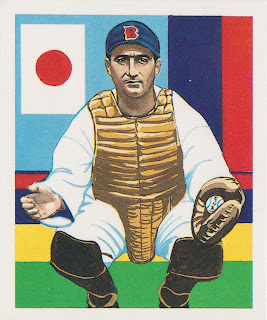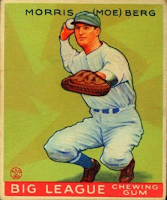Morris Berg
Boston Red Sox
Catcher
Born: March 2, 1902, New York, NY
Major League Teams: Brooklyn Dodgers 1923; Chicago White Sox 1926-1930; Cleveland Indians 1931; Washington Senators 1932-1934; Cleveland Indians 1934; Boston Red Sox 1935-1939
Died: May 29, 1972, Belleville, NJ (70)
On the field, Moe Berg was a back-up catcher and pinch-hitter who played in parts of 15 seasons in the majors, appearing in the most games with the Red Sox and White Sox. In 1928, he led all American League catchers with a 60.9% caught stealing percentage. Collecting mostly singles, Berg hit a career high .287 in 1929 while also attaining a career high with 47 RBIs. He was known for his intelligence, having graduated from Princeton University and Columbia Law School and developed a reputation around the game as an intellectual. Casey Stengel (#150) would say of Berg he was "the strangest man ever to play baseball." In 663 games, Berg collected 441 hits and batted .243 with 206 RBIs and only six home runs. He would serve as the first base coach for the Red Sox in 1940 and 1941.
Off the field, and after retiring from baseball, Berg put his intellect and his ability to speak several languages to work for the U.S. Government as a spy during and after World War II. He had previously traveled extensively throughout Europe and Asia in the early 1930s.
Following the attack on Pearl Harbor by the Japanese, Berg was sent on missions to Yugoslavia, the Caribbean, South America and Italy to gather intelligence on resistance groups, assess the physical fitness of American troops and to serve as a spy of the Nazi nuclear program. Following the war, Berg briefly worked for the CIA. He was awarded the Medal of Freedom by President Truman, but declined the honor without any public explanation. Berg's story was told in the 2018 file The Catcher Was a Spy, starring Paul Rudd in the title role.
December 16, 2020 from Albion, NY
Within days of officially deciding to collect the Diamond Stars set, I found myself searching for the 1993 extension set consisting of 36 more "what if" cards this time issued by the Chicle Fantasy Company. Individual cards from this set are very prevalent on eBay, but I wanted to buy a complete set to save myself some time and money. Given this is a relatively modern set, I was somewhat surprised at the closing auction prices for previously sold complete sets and I was happy to win my set at a lower price. These cards are gorgeous, and I can tell a lot of hard work and love for the originals went into making this tribute set. What's more, the set's creators were smart enough to start the numbering with card #120, given the 1981 extension set had left off with #120.
As I slowly collect the originals from the 1930s, I'll also highlight each of the cards from these extension sets with their own posts.
Variations Available
1 - 1993 / blue back / no statistics / 1993 copyright
The Card / Red Sox Team Set
A Japanese flag is included in the multi-color background behind Berg, alluding to his time as an American spy during the war. There's also what appears to be Japanese writing cleverly inserted on the baseball in Berg's catcher's mitt. The narrative on the back of the card is clever as well, beginning "If you were to spy Moe Berg of the Red Sox," foreshadowing his future career in espionage.
1936 Season
Berg served as a seldom used back-up to Red Sox catcher and future Hall of Famer Rick Ferrell (#48). He appeared in 39 games, making 31 starts, batting .240 with 19 RBIs. The Red Sox finished in sixth place in the American League under manager Joe Cronin (#123) with a record of 74-80-1.
|
|
|
|
|
Other Notable Baseball Cards
First Mainstream Card: 1933 Goudey #158
Topps Flagship Set Appearances (0): N/A
Most Recent Mainstream Card: 2014 Panini Golden Age #43
37 - Berg non-parallel baseball cards in the Beckett online database as of 10/22/21.
Sources:
Previous Card: #120 Lon Warneke - Chicago Cubs
Next Card: #122 Harlond Clift - St. Louis Browns











Glad to see my hard work appreciated! Cards were printed with red backs, blue backs, and infinitely variable purple-is backs. I had them switch to red ink without cleaning the press, thus creating the dark purple to kinda lavender ones.
ReplyDeleteWow - thanks for dropping by! Your expansion set was extremely well-done and very much appreciated by the collecting community and me. And I never knew different colored back variations existed, so that's great to know too.
ReplyDeleteContact me if you'd like to pick my brain about my set and my D. S. research. What # is your set? (see Paige scoreboard).
ReplyDeleteOh, and the Japanese writing was copied as best I could from a ball at Cooperstown he signed in two languages. I ran into a family who had a Japanese exchange student, and left a card with a request for her to let me know what it said. She got back to me - "Morris Berg"!
ReplyDeleteAnd, I believe it was RED ink for about 1000 sheets, then BLUE ink was added for the last 3000, which made up the 1,936 cut sets, and the also 1,936 hand-numbered (by my late wife Leatha) uncut 16x20 sheets.
Thank you for all of this, and I do plan to reach out to pick your brain at some point. I'd like to include all of this information the next time I post a card from your extension set just to make sure it's all out there. Thank you again!
ReplyDeleteI never responded to your question on what number set I have . . . mine is #1786, so one of the later sets.
ReplyDelete